engine YAMAHA MT-125 2020 Service Manual
[x] Cancel search | Manufacturer: YAMAHA, Model Year: 2020, Model line: MT-125, Model: YAMAHA MT-125 2020Pages: 96, PDF Size: 8.36 MB
Page 67 of 96
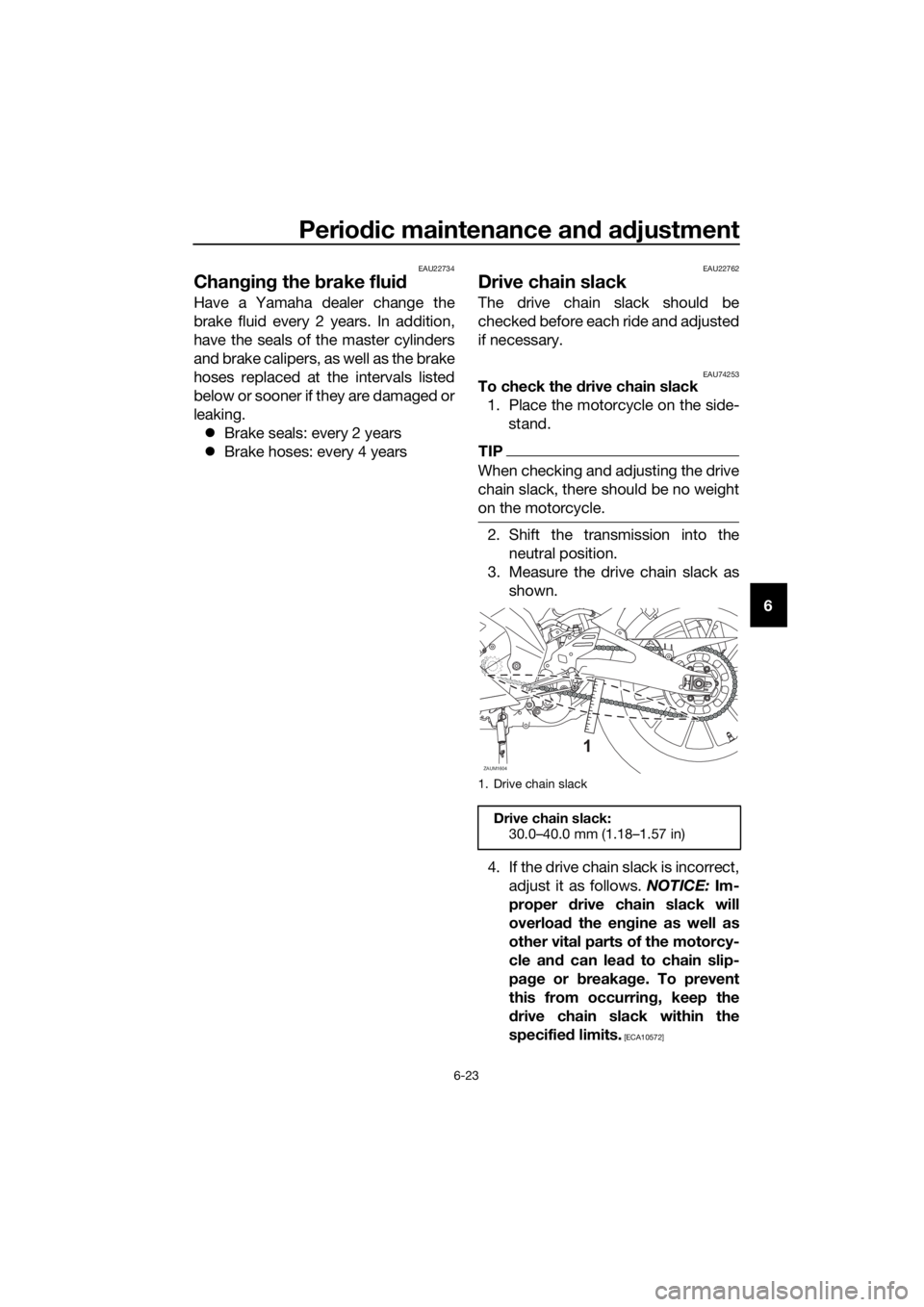
Periodic maintenance and adjustment
6-23
6
EAU22734
Changing the brake fluid
Have a Yamaha dealer change the
brake fluid every 2 years. In addition,
have the seals of the master cylinders
and brake calipers, as well as the brake
hoses replaced at the intervals listed
below or sooner if they are damaged or
leaking.
Brake seals: every 2 years
Brake hoses: every 4 years
EAU22762
Drive chain slack
The drive chain slack should be
checked before each ride and adjusted
if necessary.
EAU74253To check the drive chain slack
1. Place the motorcycle on the side-
stand.
TIP
When checking and adjusting the drive
chain slack, there should be no weight
on the motorcycle.
2. Shift the transmission into the
neutral position.
3. Measure the drive chain slack as
shown.
4. If the drive chain slack is incorrect,
adjust it as follows. NOTICE: Im-
proper drive chain slack will
overload the engine as well as
other vital parts of the motorcy-
cle and can lead to chain slip-
page or breakage. To prevent
this from occurring, keep the
drive chain slack within the
specified limits.
[ECA10572]
1. Drive chain slack
Drive chain slack:
30.0–40.0 mm (1.18–1.57 in)
ZAUM1604
1
UB6GE0E0.book Page 23 Wednesday, August 28, 2019 11:11 AM
Page 69 of 96
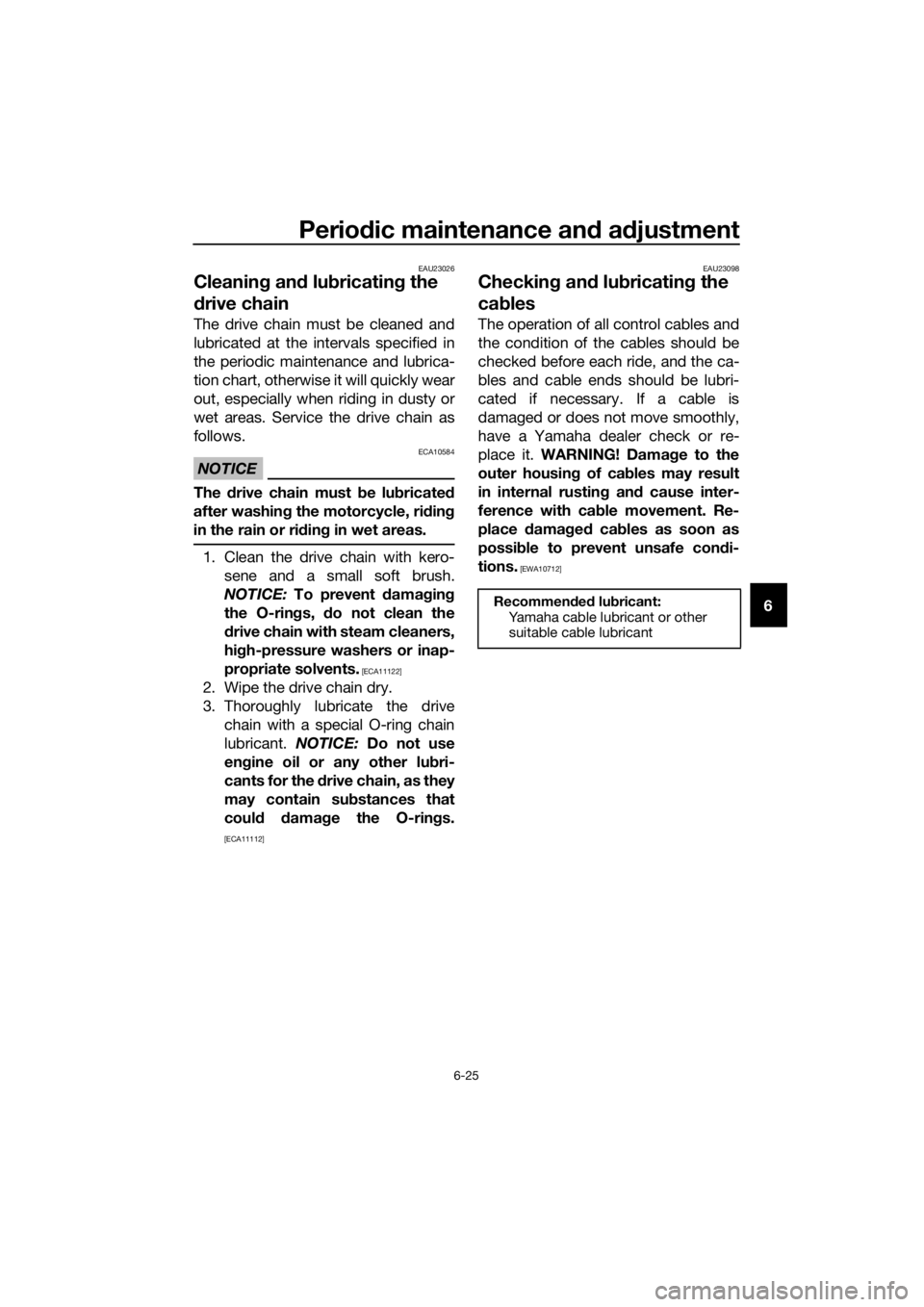
Periodic maintenance and adjustment
6-25
6
EAU23026
Cleaning and lubricating the
drive chain
The drive chain must be cleaned and
lubricated at the intervals specified in
the periodic maintenance and lubrica-
tion chart, otherwise it will quickly wear
out, especially when riding in dusty or
wet areas. Service the drive chain as
follows.
NOTICE
ECA10584
The drive chain must be lubricated
after washing the motorcycle, riding
in the rain or riding in wet areas.
1. Clean the drive chain with kero-
sene and a small soft brush.
NOTICE: To prevent damaging
the O-rings, do not clean the
drive chain with steam cleaners,
high-pressure washers or inap-
propriate solvents.
[ECA11122]
2. Wipe the drive chain dry.
3. Thoroughly lubricate the drive
chain with a special O-ring chain
lubricant. NOTICE: Do not use
engine oil or any other lubri-
cants for the drive chain, as they
may contain substances that
could damage the O-rings.
[ECA11112]EAU23098
Checking and lubricating the
cables
The operation of all control cables and
the condition of the cables should be
checked before each ride, and the ca-
bles and cable ends should be lubri-
cated if necessary. If a cable is
damaged or does not move smoothly,
have a Yamaha dealer check or re-
place it. WARNING! Damage to the
outer housing of cables may result
in internal rusting and cause inter-
ference with cable movement. Re-
place damaged cables as soon as
possible to prevent unsafe condi-
tions.
[EWA10712]
Recommended lubricant:
Yamaha cable lubricant or other
suitable cable lubricant
UB6GE0E0.book Page 25 Wednesday, August 28, 2019 11:11 AM
Page 80 of 96
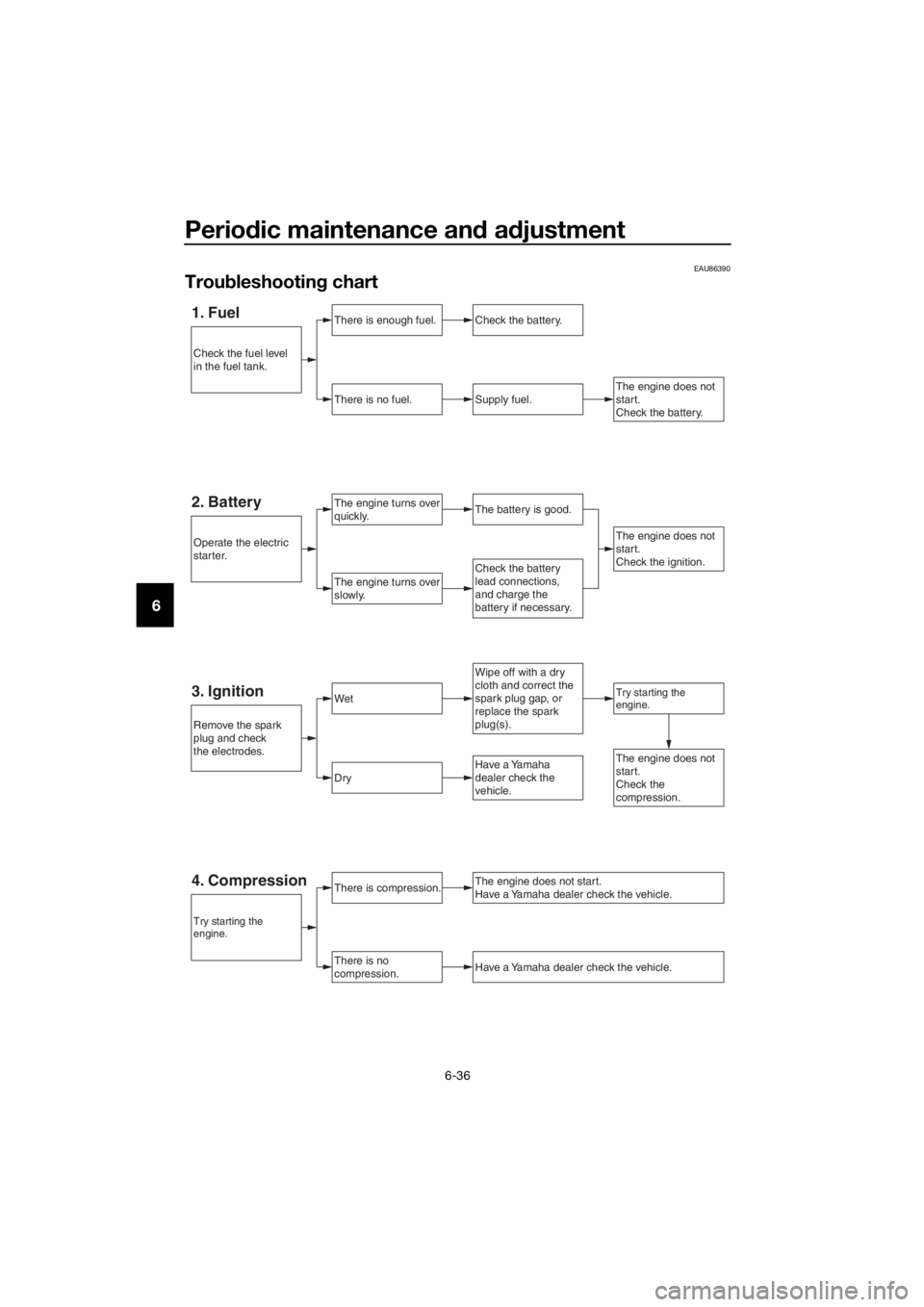
Periodic maintenance and adjustment
6-36
6
EAU86390
Troubleshooting chart
1. FuelThere is enough fuel.
There is no fuel.
Check the battery.
Supply fuel.
The engine turns over
quickly.
The engine turns over
slowly.
Try starting the
engine.
The engine does not
start.
Check the battery.
Wipe off with a dry
cloth and correct the
spark plug gap, or
replace the spark
plug(s).
Check the battery
lead connections,
and charge the
battery if necessary.
2. BatteryThe battery is good.
The engine does not
start.
Check the ignition.
3. IgnitionWet
Dry
There is compression.
There is no
compression.
The engine does not start.
Have a Yamaha dealer check the vehicle.
Have a Yamaha dealer check the vehicle.
The engine does not
start.
Check the
compression.Have a Yamaha
dealer check the
vehicle.
Remove the spark
plug and check
the electrodes.
Operate the electric
starter.
Try starting the
engine.
Check the fuel level
in the fuel tank.
4. Compression
UB6GE0E0.book Page 36 Wednesday, August 28, 2019 11:11 AM
Page 81 of 96
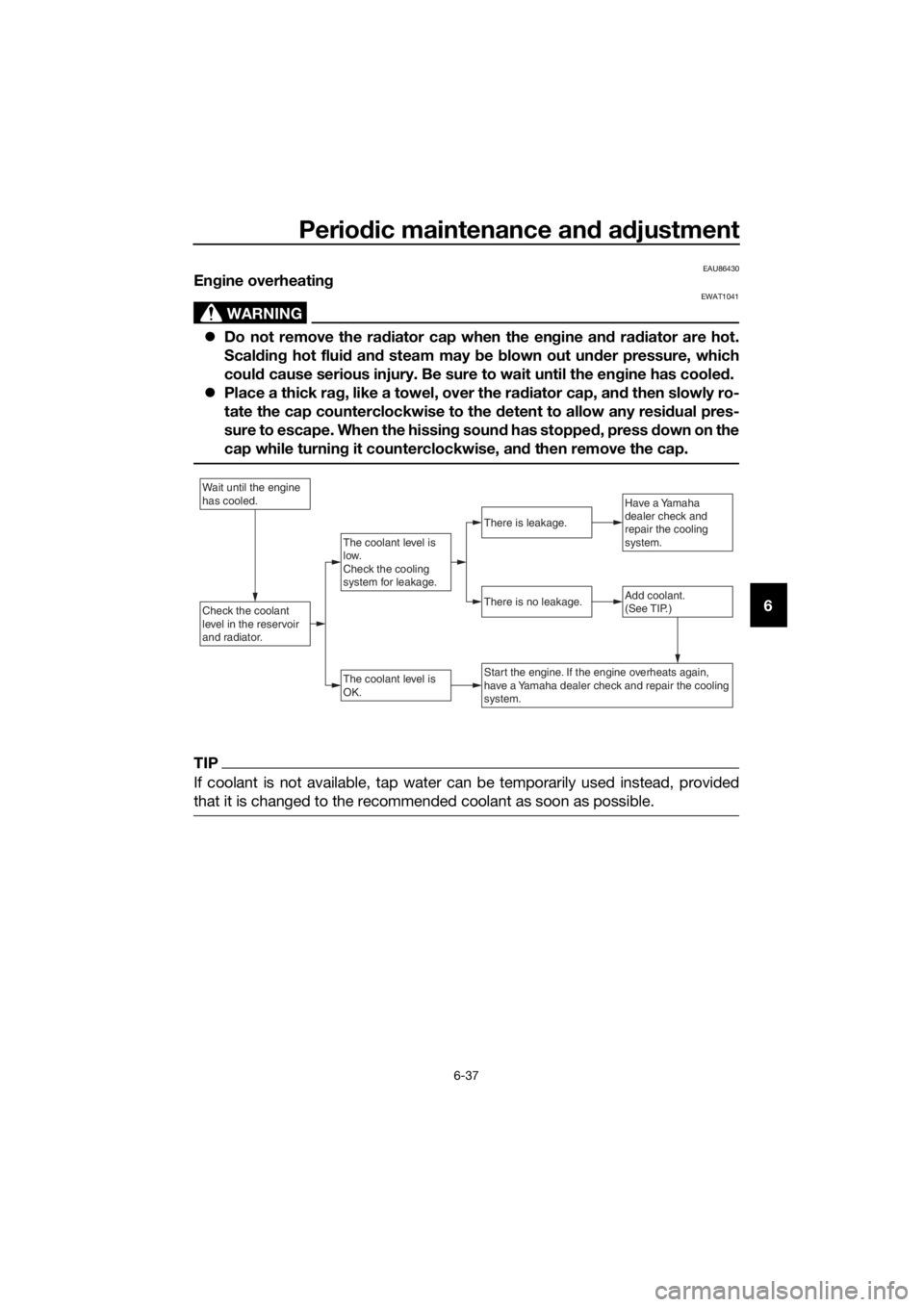
Periodic maintenance and adjustment
6-37
6
EAU86430Engine overheating
WARNING
EWAT1041
Do not remove the radiator cap when the engine and radiator are hot.
Scalding hot fluid and steam may be blown out under pressure, which
could cause serious injury. Be sure to wait until the engine has cooled.
Place a thick rag, like a towel, over the radiator cap, and then slowly ro-
tate the cap counterclockwise to the detent to allow any residual pres-
sure to escape. When the hissing sound has stopped, press down on the
cap while turning it counterclockwise, and then remove the cap.
TIP
If coolant is not available, tap water can be temporarily used instead, provided
that it is changed to the recommended coolant as soon as possible.
Wait until the engine
has cooled.
Check the coolant
level in the reservoir
and radiator.Add coolant.
(See TIP.)
The coolant level is
OK.
There is no leakage.
There is leakage.
The coolant level is
low.
Check the cooling
system for leakage.
Have a Yamaha
dealer check and
repair the cooling
system.
Start the engine. If the engine overheats again,
have a Yamaha dealer check and repair the cooling
system.
UB6GE0E0.book Page 37 Wednesday, August 28, 2019 11:11 AM
Page 84 of 96
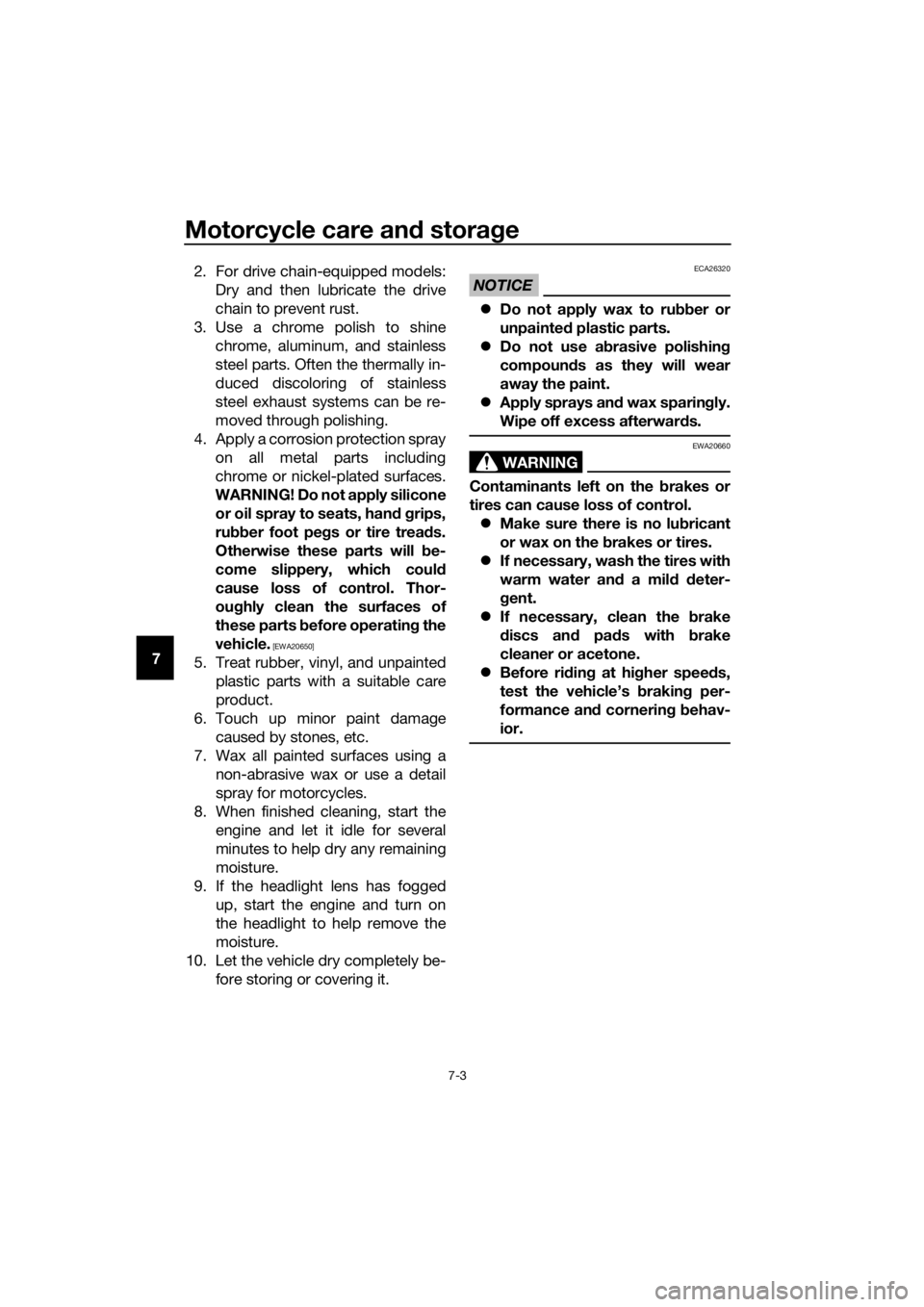
Motorcycle care and storage
7-3
72. For drive chain-equipped models:
Dry and then lubricate the drive
chain to prevent rust.
3. Use a chrome polish to shine
chrome, aluminum, and stainless
steel parts. Often the thermally in-
duced discoloring of stainless
steel exhaust systems can be re-
moved through polishing.
4. Apply a corrosion protection spray
on all metal parts including
chrome or nickel-plated surfaces.
WARNING! Do not apply silicone
or oil spray to seats, hand grips,
rubber foot pegs or tire treads.
Otherwise these parts will be-
come slippery, which could
cause loss of control. Thor-
oughly clean the surfaces of
these parts before operating the
vehicle. [EWA20650]
5. Treat rubber, vinyl, and unpainted
plastic parts with a suitable care
product.
6. Touch up minor paint damage
caused by stones, etc.
7. Wax all painted surfaces using a
non-abrasive wax or use a detail
spray for motorcycles.
8. When finished cleaning, start the
engine and let it idle for several
minutes to help dry any remaining
moisture.
9. If the headlight lens has fogged
up, start the engine and turn on
the headlight to help remove the
moisture.
10. Let the vehicle dry completely be-
fore storing or covering it.
NOTICE
ECA26320
Do not apply wax to rubber or
unpainted plastic parts.
Do not use abrasive polishing
compounds as they will wear
away the paint.
Apply sprays and wax sparingly.
Wipe off excess afterwards.
WARNING
EWA20660
Contaminants left on the brakes or
tires can cause loss of control.
Make sure there is no lubricant
or wax on the brakes or tires.
If necessary, wash the tires with
warm water and a mild deter-
gent.
If necessary, clean the brake
discs and pads with brake
cleaner or acetone.
Before riding at higher speeds,
test the vehicle’s braking per-
formance and cornering behav-
ior.
UB6GE0E0.book Page 3 Wednesday, August 28, 2019 11:11 AM
Page 85 of 96
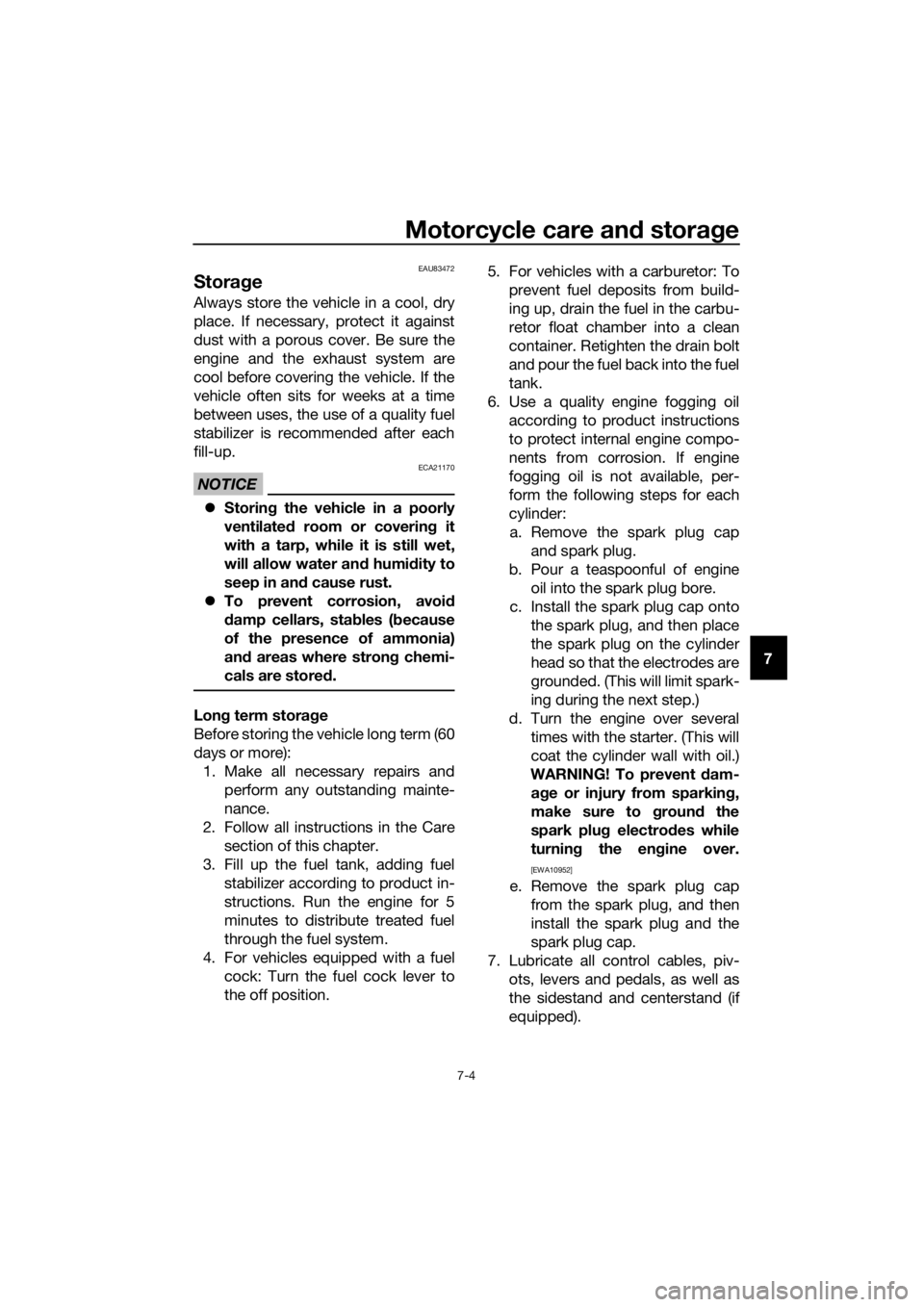
Motorcycle care and storage
7-4
7
EAU83472
Storage
Always store the vehicle in a cool, dry
place. If necessary, protect it against
dust with a porous cover. Be sure the
engine and the exhaust system are
cool before covering the vehicle. If the
vehicle often sits for weeks at a time
between uses, the use of a quality fuel
stabilizer is recommended after each
fill-up.
NOTICE
ECA21170
Storing the vehicle in a poorly
ventilated room or covering it
with a tarp, while it is still wet,
will allow water and humidity to
seep in and cause rust.
To prevent corrosion, avoid
damp cellars, stables (because
of the presence of ammonia)
and areas where strong chemi-
cals are stored.
Long term storage
Before storing the vehicle long term (60
days or more):
1. Make all necessary repairs and
perform any outstanding mainte-
nance.
2. Follow all instructions in the Care
section of this chapter.
3. Fill up the fuel tank, adding fuel
stabilizer according to product in-
structions. Run the engine for 5
minutes to distribute treated fuel
through the fuel system.
4. For vehicles equipped with a fuel
cock: Turn the fuel cock lever to
the off position.5. For vehicles with a carburetor: To
prevent fuel deposits from build-
ing up, drain the fuel in the carbu-
retor float chamber into a clean
container. Retighten the drain bolt
and pour the fuel back into the fuel
tank.
6. Use a quality engine fogging oil
according to product instructions
to protect internal engine compo-
nents from corrosion. If engine
fogging oil is not available, per-
form the following steps for each
cylinder:
a. Remove the spark plug cap
and spark plug.
b. Pour a teaspoonful of engine
oil into the spark plug bore.
c. Install the spark plug cap onto
the spark plug, and then place
the spark plug on the cylinder
head so that the electrodes are
grounded. (This will limit spark-
ing during the next step.)
d. Turn the engine over several
times with the starter. (This will
coat the cylinder wall with oil.)
WARNING! To prevent dam-
age or injury from sparking,
make sure to ground the
spark plug electrodes while
turning the engine over.
[EWA10952]
e. Remove the spark plug cap
from the spark plug, and then
install the spark plug and the
spark plug cap.
7. Lubricate all control cables, piv-
ots, levers and pedals, as well as
the sidestand and centerstand (if
equipped).
UB6GE0E0.book Page 4 Wednesday, August 28, 2019 11:11 AM
Page 87 of 96
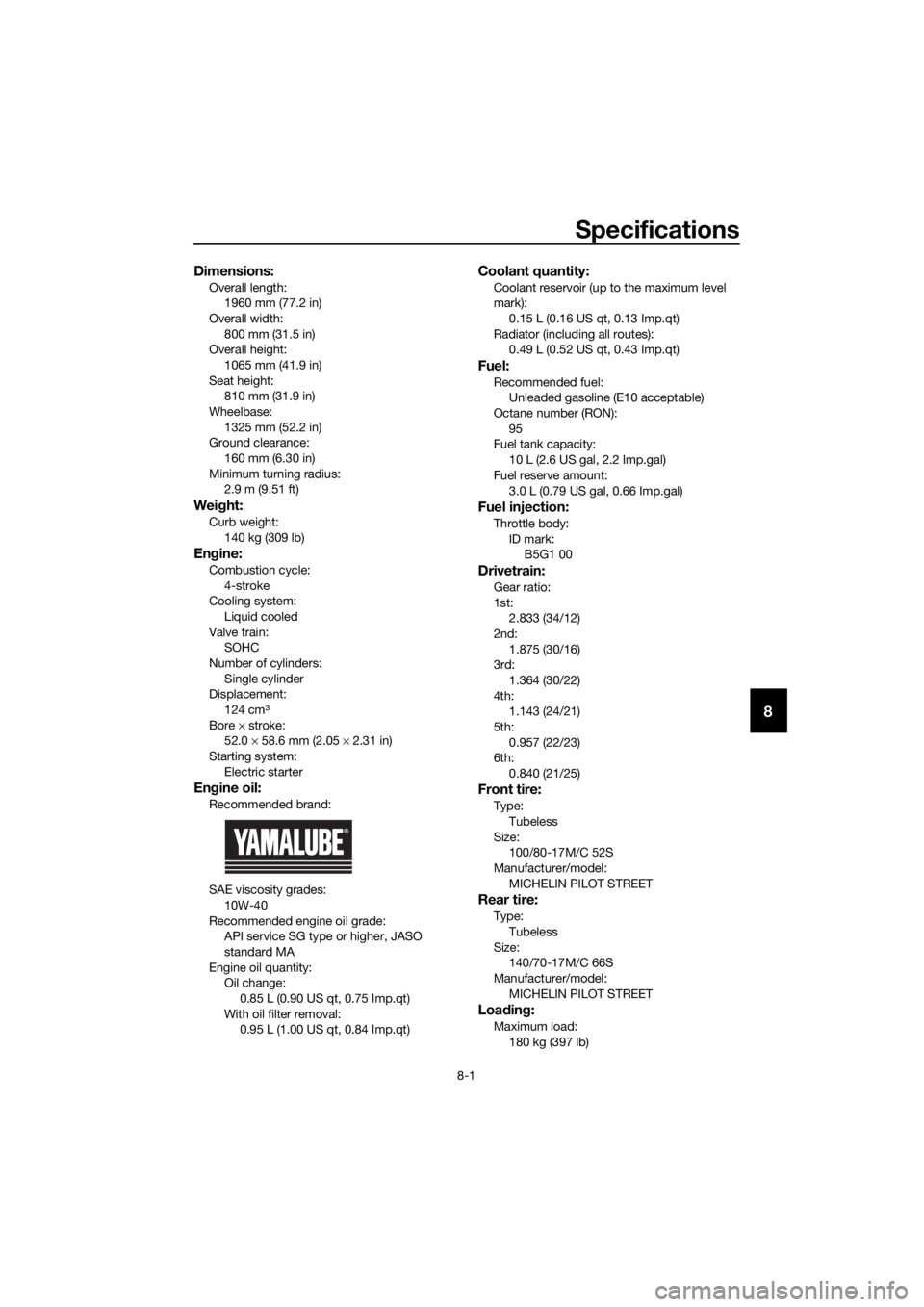
Specifications
8-1
8
Dimensions:
Overall length:
1960 mm (77.2 in)
Overall width:
800 mm (31.5 in)
Overall height:
1065 mm (41.9 in)
Seat height:
810 mm (31.9 in)
Wheelbase:
1325 mm (52.2 in)
Ground clearance:
160 mm (6.30 in)
Minimum turning radius:
2.9 m (9.51 ft)
Weight:
Curb weight:
140 kg (309 lb)
Engine:
Combustion cycle:
4-stroke
Cooling system:
Liquid cooled
Valve train:
SOHC
Number of cylinders:
Single cylinder
Displacement:
124 cm³
Bore × stroke:
52.0 × 58.6 mm (2.05 × 2.31 in)
Starting system:
Electric starter
Engine oil:
Recommended brand:
SAE viscosity grades:
10W-40
Recommended engine oil grade:
API service SG type or higher, JASO
standard MA
Engine oil quantity:
Oil change:
0.85 L (0.90 US qt, 0.75 Imp.qt)
With oil filter removal:
0.95 L (1.00 US qt, 0.84 Imp.qt)
Coolant quantity:
Coolant reservoir (up to the maximum level
mark):
0.15 L (0.16 US qt, 0.13 Imp.qt)
Radiator (including all routes):
0.49 L (0.52 US qt, 0.43 Imp.qt)
Fuel:
Recommended fuel:
Unleaded gasoline (E10 acceptable)
Octane number (RON):
95
Fuel tank capacity:
10 L (2.6 US gal, 2.2 Imp.gal)
Fuel reserve amount:
3.0 L (0.79 US gal, 0.66 Imp.gal)
Fuel injection:
Throttle body:
ID mark:
B5G1 00
Drivetrain:
Gear ratio:
1st:
2.833 (34/12)
2nd:
1.875 (30/16)
3rd:
1.364 (30/22)
4th:
1.143 (24/21)
5th:
0.957 (22/23)
6th:
0.840 (21/25)
Front tire:
Type:
Tubeless
Size:
100/80-17M/C 52S
Manufacturer/model:
MICHELIN PILOT STREET
Rear tire:
Type:
Tubeless
Size:
140/70-17M/C 66S
Manufacturer/model:
MICHELIN PILOT STREET
Loading:
Maximum load:
180 kg (397 lb)
UB6GE0E0.book Page 1 Wednesday, August 28, 2019 11:11 AM
Page 89 of 96

Consumer information
9-1
9
EAU53562
Identification numbers
Record the vehicle identification num-
ber, engine serial number, and the
model label information in the spaces
provided below. These identification
numbers are needed when registering
the vehicle with the authorities in your
area and when ordering spare parts
from a Yamaha dealer.
VEHICLE IDENTIFICATION NUMBER:
ENGINE SERIAL NUMBER:
MODEL LABEL INFORMATION:
EAU26401Vehicle identification numberThe vehicle identification number is
stamped into the steering head pipe.
Record this number in the space pro-
vided.
TIP
The vehicle identification number is
used to identify your motorcycle and
may be used to register your motorcy-
cle with the licensing authority in your
area.
EAU26442Engine serial number
The engine serial number is stamped
into the crankcase.
EAU26481Model label
The model label is affixed to the frame
under the seat. (See page 3-19.) Re-
cord the information on this label in the
1. Vehicle identification number
1
1. Engine serial number
1. Model label
1
1
UB6GE0E0.book Page 1 Wednesday, August 28, 2019 11:11 AM
Page 91 of 96
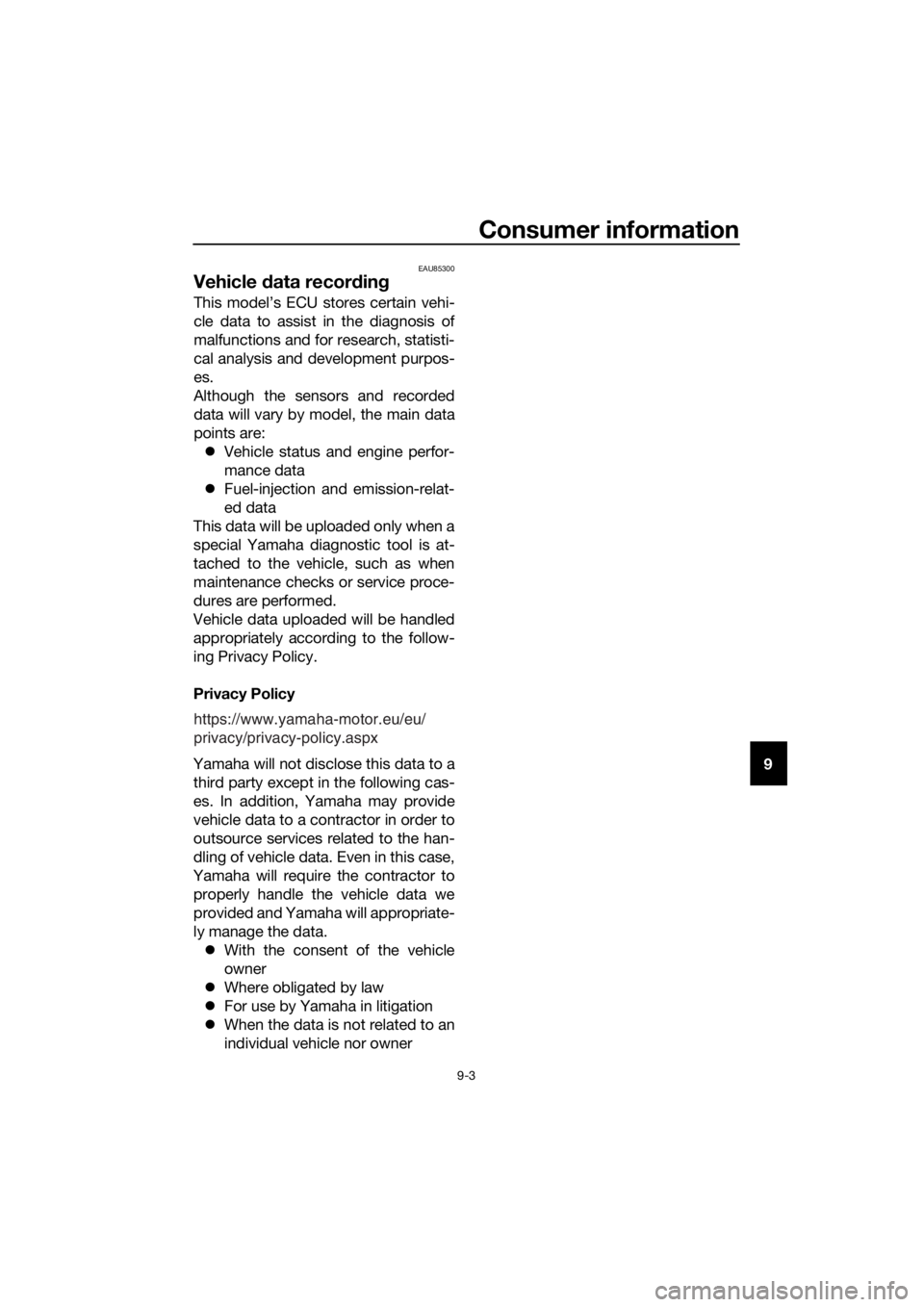
Consumer information
9-3
9
EAU85300
Vehicle data recording
This model’s ECU stores certain vehi-
cle data to assist in the diagnosis of
malfunctions and for research, statisti-
cal analysis and development purpos-
es.
Although the sensors and recorded
data will vary by model, the main data
points are:
Vehicle status and engine perfor-
mance data
Fuel-injection and emission-relat-
ed data
This data will be uploaded only when a
special Yamaha diagnostic tool is at-
tached to the vehicle, such as when
maintenance checks or service proce-
dures are performed.
Vehicle data uploaded will be handled
appropriately according to the follow-
ing Privacy Policy.
Privacy Policy
Yamaha will not disclose this data to a
third party except in the following cas-
es. In addition, Yamaha may provide
vehicle data to a contractor in order to
outsource services related to the han-
dling of vehicle data. Even in this case,
Yamaha will require the contractor to
properly handle the vehicle data we
provided and Yamaha will appropriate-
ly manage the data.
With the consent of the vehicle
owner
Where obligated by law
For use by Yamaha in litigation
When the data is not related to an
individual vehicle nor owner
https://www.yamaha-motor.eu/eu/
privacy/privacy-policy.aspx
UB6GE0E0.book Page 3 Wednesday, August 28, 2019 11:11 AM
Page 92 of 96

10-1
10
Index
A
ABS ....................................................... 3-15
ABS warning light ................................... 3-3
Air filter element and check hose,
replacing and cleaning ....................... 6-13
B
Battery .................................................. 6-30
Brake and clutch levers, checking and
lubricating ........................................... 6-27
Brake and shift pedals, checking and
lubricating ........................................... 6-26
Brake fluid, changing ............................ 6-23
Brake fluid level, checking .................... 6-22
Brake lever ............................................ 3-14
Brake light switches.............................. 6-20
Brake pedal........................................... 3-14
Brake pedal free play, adjusting ........... 6-20
C
Cables, checking and lubricating ......... 6-25
Care ........................................................ 7-1
Catalytic converter ................................ 3-18
Clutch lever ........................................... 3-13
Clutch lever free play, adjusting ........... 6-18
Coolant ................................................. 6-11
Coolant temperature warning light ......... 3-2
Cowlings, removing and installing .......... 6-7
D
Data recording, vehicle ........................... 9-3
Diagnostic connectors ............................ 9-2
Dimmer switch ...................................... 3-12
Drive chain, cleaning and lubricating .... 6-25
Drive chain slack................................... 6-23
E
Engine break-in....................................... 5-1
Engine idling speed .............................. 6-13
Engine oil and oil filter element ............... 6-8
Engine overheating ............................... 6-37
Engine serial number .............................. 9-1
Engine trouble warning light ................... 3-3
F
Front and rear brake pads, checking.... 6-21
Front brake lever free play, checking ... 6-19
Front fork, checking .............................. 6-28
Fuel ....................................................... 3-16
Fuel consumption, tips for reducing ....... 5-5
Fuel tank cap ........................................ 3-16
Fuel tank overflow hose ........................ 3-18
Fuses, replacing.................................... 6-31
H
Handlebar switches .............................. 3-12Helmet holder ....................................... 3-20
High beam indicator light ....................... 3-2
Horn switch .......................................... 3-12
I
Identification numbers ............................ 9-1
Ignition circuit cut-off system............... 3-21
Indicator lights and warning lights ......... 3-2
L
License plate light bulb, replacing........ 6-34
M
Main switch/steering lock....................... 3-1
Maintenance and lubrication, periodic ... 6-4
Maintenance, emission control
system.................................................. 6-3
Matte color, caution ............................... 7-1
Model label ............................................. 9-1
Multi-function meter unit ........................ 3-4
N
Neutral indicator light ............................. 3-2
P
Parking ................................................... 5-6
Part locations ......................................... 2-1
Pass switch .......................................... 3-12
S
Safety information .................................. 1-1
Seat ...................................................... 3-19
Shifting ................................................... 5-4
Shift light ................................................ 3-3
Shift pedal ............................................ 3-13
Sidestand ............................................. 3-20
Sidestand, checking and lubricating .... 6-27
Spark plug, checking ............................. 6-7
Specifications ......................................... 8-1
Start/Engine stop switch ...................... 3-12
Starting the engine ................................. 5-2
Steering, checking................................ 6-29
Storage ................................................... 7-4
Supporting the motorcycle................... 6-34
Swingarm pivots, lubricating ................ 6-28
T
Tail/brake light ...................................... 6-33
Throttle grip and cable, checking and
lubricating .......................................... 6-26
Throttle grip free play, adjusting........... 6-14
Tires ...................................................... 6-15
Tool kit.................................................... 6-2
Troubleshooting ................................... 6-35
Troubleshooting chart .......................... 6-36
Turn signal indicator light ....................... 3-2
Turn signal light bulb, replacing ........... 6-33
UB6GE0E0.book Page 1 Wednesday, August 28, 2019 11:11 AM